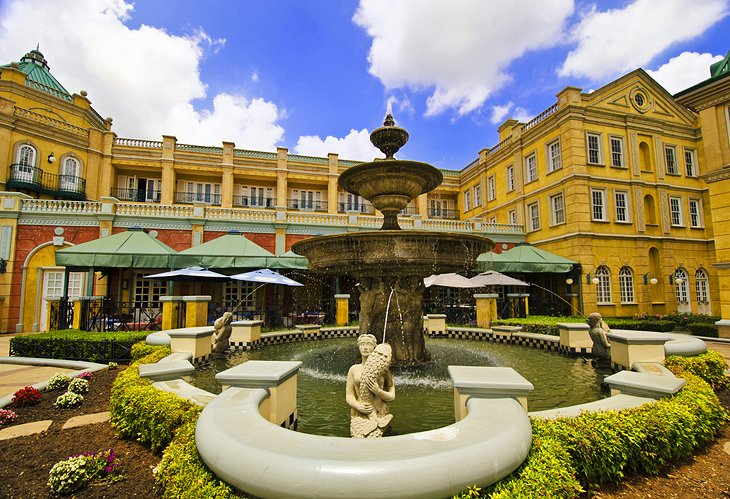The Greatest Guide To Johannesburg North Attractions
The Greatest Guide To Johannesburg North Attractions
Blog Article
An Unbiased View of Johannesburg North Attractions
Table of ContentsThe 7-Second Trick For Johannesburg North AttractionsJohannesburg North Attractions Things To Know Before You Get ThisRumored Buzz on Johannesburg North AttractionsAn Unbiased View of Johannesburg North AttractionsSome Of Johannesburg North AttractionsOur Johannesburg North Attractions Statements
The city owes its location to the visibility of an even a lot more priceless source: gold. The city expanded on the edge of the Witwatersrand Key Reef, a below ground stratum of gold-bearing quartz-silica conglomerate that arcs for hundreds of miles underneath the Highveld. The majority of the gold mines in the city stopped procedure in the 1970s, yet in its day the Witwatersrand gold market represented greater than 40 percent of the globe's annual gold production.Johannesburg has a warm environment. Summer season temperature levels balance concerning 75 F (24 C); winter months temperature levels average about 55 F (13 C) and just occasionally dip listed below cold. The city appreciates about eight hours of sunlight daily in both wintertime and summertime. Rainfall standards concerning 28 inches (700 millimetres) per year, but the overall varies significantly from year to year.
What rainfall the city gets drops almost exclusively in the summer season months, usually in magnificent late-afternoon electrical tornados., where many locals still depend on coal for gas.

How Johannesburg North Attractions can Save You Time, Stress, and Money.
The equilibrium of the city is occupied by whites. Accommodation varies in character and quality. Soweto is infamous for its endless rows of municipally developed, two-room matchbox homes, yet it additionally has a few flourishing enclaves along with teeming squatter camps, where 10s of thousands live without water, electrical power, or sanitation facilities.
Physical growth, although rather restricted by transportation, continued rapidly as immigration to South Africa, and Johannesburg specifically, boosted significantly. This trouble was addressed in the 1930s when the automobile was presented in automation to South Africa. Automobiles were, for the many component, confined to the affluent, and permitted them to transfer to the north of the city and commute right into the centre.
The majority of inadequate residential areas were mixed, with poor blacks and whites cohabiting, although the well-off residential areas were normally scheduled for whites. This changed with the political election of the National Party in the 1948 elections, that started to formalise the system known as racism. Apartheid officially designated which suburban areas each race could reside in under the Group Areas Act.
The previous system of eleven numbered areas was reorganised in 2006. Marshalltown, as seen from the top of the Carlton Centre. The M1 and M2 run behind the structures, and the southern suburbs expand past the freeway limit. The central city of Johannesburg is located within the city's Area F. The estimated populace of the area is 200,000, [] however the number of individuals residing in the inner city on a casual basis is unidentified, as many are prohibited immigrants. Many higher-income homeowners and white people have relocated to the northern residential areas and have been changed by lower-income black individuals. The unemployment, education, and age accounts of the area are all unidentified, due to the difficulty of acquiring trustworthy information concerning the location.
The smart Trick of Johannesburg North Attractions That Nobody is Talking About
Yeoville and Bellevue have a mix of apartment and solitary domestic systems on little lots. The area is situated on a mountainous divide that runs from eastern to west. The most noticeable geographical attribute is Observatory Ridge, which is called for the big observatory located on it. The entertainment areas are no more used, because of safety and security issues.

The Main Principles Of Johannesburg North Attractions
The eastern suburbs are some of the oldest areas of Johannesburg, there are big neighborhoods of Jewish and click resources other European histories, the majority of the populace is English talking. There are three golf programs as well as a number of protected ridges with viewsites.
Initially constructed to house male migrant workers, several have actually been improved as dwellings for pairs and households. The residential area was not traditionally enabled to produce employment centres within the area, so virtually all of its residents are commuters to other components of the city.
Indicators on Johannesburg North Attractions You Should Know
The property areas in the north suburbs are mostly formal, with no substantial areas of casual housing, or real estate that lacks a permanent structure. This is an established location, there is a trend of Get the facts land usage modification from household to commercial, especially along primary arterial roads and around recognized nodes.
Roadways to the eastern and west are much less well established, as there are no freeways taking a trip in that instructions. Towards the north boundary of the city, the thickness of advancement lowers, leaving large areas of untaught land around Midrand.
Some Known Details About Johannesburg North Attractions
The very first suburb to the north of the inner city is Parktown, which is located on a hill ignoring the inner city check it out and Hillbrow. It has numerous wealthy locals and Edwardian-style manors, along with the Education and learning and Medical schools of the University of the Witwatersrand. The big concrete Charlotte Maxeke Johannesburg Academic Health Center dominates the horizon of Parktown.
Report this page